
Looking for How to Easily Make Pesto from Fresh Basil! EASY and illustrated instructions! in 2025? Scroll down this page and follow the links. And if you bring home some fruit or vegetables and want to can, freeze, make jam, salsa or pickles, see this page for simple, reliable, illustrated canning, freezing or preserving directions. There are plenty of other related resources, click on the resources dropdown above. If you are having a hard time finding canning lids, I've used these, and they're a great price & ship in 2 days.
If you have questions or feedback, please let me know! There are affiliate links on this page. Read our disclosure policy to learn more.
How to Easily Make Pesto from Fresh Basil! EASY and illustrated instructions!
How to Easily Make Pesto from Fresh Basil!
As expensive as basil pesto is in the stores, you'd think it was difficult to make; but it is incredibly easy. The only equipment you need is a food processor, blender or chopper.
 Ingredients
Ingredients
- 2 cups fresh packed basil leaves (packed means, stuff them into a measure cup and press them down with your hand; it's not a precise measurement)
- 1/4 cup grated Parmesan cheese
- 1/4 cup pine nuts (if you don't have pine nuts, you can use walnuts or hazelnuts)
- 3 garlic cloves, finely minced (or 1 tablespoon of prepared minced garlic)
- 1 tablespoon "fruit fresh" or 1 tablespoon of lemon juice. Fruit fresh is available at most grocery stores where canning supplied like pectin and pickling salt are sold. It is basically a form of citric acid and vitamin C, that helps prevent the pesto from turning brown upon exposure to the air.
-
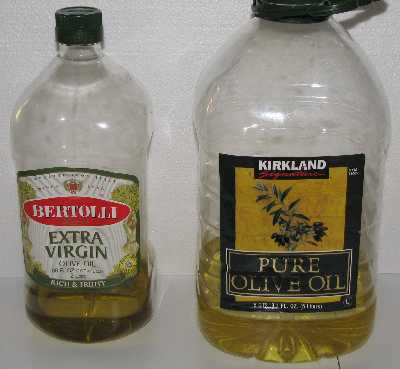 1/4 cup Olive oil. It should be
the "extra virgin" variety, not the ordinary cooking olive oil. If it is extra virgin, it will say that on the label: see the photo for an example of
extra virgin (at left) next to cooking olive oil (at right).
1/4 cup Olive oil. It should be
the "extra virgin" variety, not the ordinary cooking olive oil. If it is extra virgin, it will say that on the label: see the photo for an example of
extra virgin (at left) next to cooking olive oil (at right).
Makes about 1 cup or prepared basil Pesto!
Directions
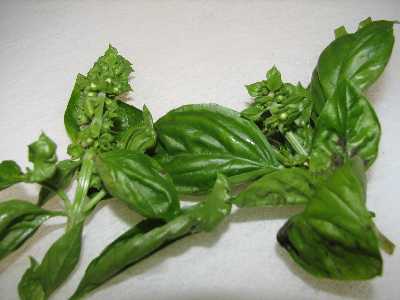 Step 1 - Pick the leaves off of the stems.
Step 1 - Pick the leaves off of the stems.
Discard any flower buds, stems or leaves that aren't in good shape. All we want are leaves; small, medium or large; as long as they are a healthy green, not brown or molding!
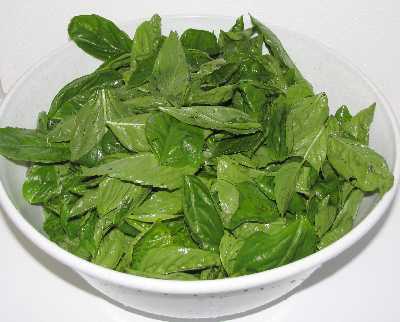 Step 2 - Wash the basil.
Step 2 - Wash the basil.
Just wash them in a large bowl under cold water, no soap!

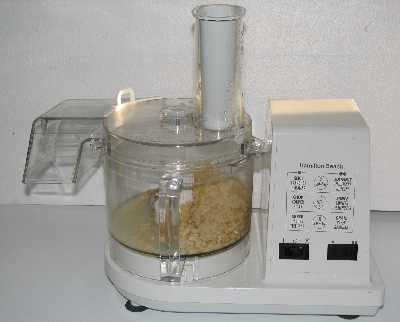 Step 3 - Chop the pine nuts, olive oil and garlic in the food processor
Step 3 - Chop the pine nuts, olive oil and garlic in the food processor
If you don't have a food processor, you can use a blender, and possibly a chopper. It would be fairly tedious to do this by hand, but I'm sure it can be done that way, too.
Step 4 - Add the basil leaves and olive oil and chop
 Now start stuffing basil leaves (in small batches) into the food processor
and chop them into the garlic, olive oil and pine nuts.
Now start stuffing basil leaves (in small batches) into the food processor
and chop them into the garlic, olive oil and pine nuts.
Chop the mix until it forms a thick, smooth paste.
Step 5 - Blend in the grated Parmesan cheese
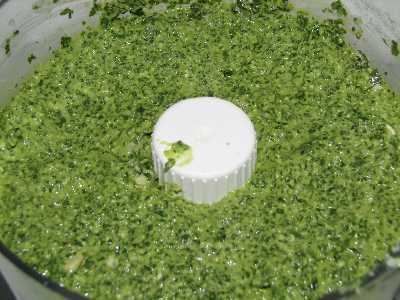 Did I mention you need to grate the Parmesan cheese first? Then just add it
to the food processor and blend! NOTE: if you intend to freeze the pesto, leave the cheese OUT and add it when you thaw and use the pesto. Cheese
doesn't freeze well.
Did I mention you need to grate the Parmesan cheese first? Then just add it
to the food processor and blend! NOTE: if you intend to freeze the pesto, leave the cheese OUT and add it when you thaw and use the pesto. Cheese
doesn't freeze well.
And that is it! You're done! It should look like the photo at right -->
Secret Tip:
Adding 1 teaspoon of sugar or Stevia (in a prepared form like Truvia, it measures same as sugar; if you use another form, you will need do your own conversion) - or Splenda, if you prefer, to the batch really seems to bring the flavor alive. Try it and see!
The pesto will keep in refrigerator for about a week, or you can freeze it and it will last for 3 to 6 months.
A visitor writes to suggest freezing the pesto in ice cube trays. When it's frozen, just pop the cubes out of the tray and put them into a freezer bag. When you need them, just take one of two of the cubes out - so easy!
Serving?
Most people serve it over pasta or use it to season fish and chicken dishes.
Frequently asked questions
Herbs and oils are both low-acid and together could support the growth of the disease-causing Clostridium botulinum bacteria. University (Clemson, University of Georgia, etc.) food science researchers do NOT recommend canning herbs .
However, herbs and herb mixtures like pesto CAN be safely frozen! Pesto is an uncooked seasoning mixture of herbs, usually including fresh basil, and some oil. It may be frozen for long term storage. That's the recommended method to save your homemade pesto for the dark nights of winter!
Also, oils may be flavored with herbs if they are made up for fresh use, stored in the refrigerator and used within 2 to 3 days. Fresh herbs must be washed well and dried completely before storing in the oil. The very best sanitation and personal hygiene practices must be used.
Looking for canning equipment and supplies?
Water bath canner with a jar rack
Pressure canners for gas, electric and induction stoves: Presto 23Qt or T-fal 22Qt
Canning scoop (this one is PERFECT)
Ball Blue book (most recent version)
Jars: 8oz canning jars for jams
Find Other types of farms:
Farm markets and roadside stands
Road trips and camping resources
Local Honey, apiaries, beekeepers
Consumer fraud and scams information
Home canning supplies at the best prices on the internet!
Maple Syrup Farms, sugarworks, maple syrup festivals
Environmental information and resources
Farms For Your Event for birthday parties, weddings, receptions, business meetings, retreats, etc.
Festivals - local fruit and vegetable festivals
Get the
most recent version of
the Ball Blue Book
With this Presto 23 quart pressure canner and pressure cooker, you can "can" everything, fruits, vegetables, jams, jellies, salsa, applesauce, pickles, even meats, soups, stews. Model 01781

You can make jams, jellies, can fruit, applesauce, salsa and pickles with water bath canners, like this Granite Ware 12-Piece Canner Kit, Jar Rack, Blancher, Colander and 5 piece Canning Tool Set

